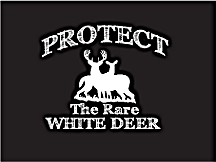
Bates Letter to DNR Board
To the Natural Resources Board:
I am writing in regards to the request before you to harvest white/albino deer in Wisconsin, and specifically to the statement in the request: “Some landowners report seeing only white deer during the hunting season and dominant white bucks seem to chase other bucks away preventing harvest opportunities.”
This statement has no merit biologically. For one, the math simply doesn’t work. You may know how recessive traits work, but if not, here’s how it works with deer. Because albinism is a recessive genetic trait, both parents must carry the recessive gene before an albino fawn can potentially be produced. All genes are paired in the offspring, one gene in each pair coming from each parent. So, in an individual deer, when a recessive gene is paired with a dominant gene, the traits displayed by the recessive gene remain hidden. But when two deer with the recessive genes mate, the two recessive genes can get paired and become dominant.
No one knows how many deer carry the recessive trait for albinism, but in humans, about one in 200 people carry it, which only translates into about one in 20,000 humans actually becoming albinos.
Why such a difference in numbers between “normal” and albino offspring? Unless both parents carry the recessive gene, their offspring can’t inherit a recessive gene. Since recessive genes for albinism are rare in the first place, the chances of two deer with the recessive gene finding each other and mating are even rarer. Even then, it’s still only a one-in-four chance that the offspring they produce will be an albino. That’s why mammalogists estimate that only one in 10,000 fawns will be an albino.
Here’s how it works:
A normally-colored doe with no recessive genes bred to a normally-colored buck with no recessive genes will always produce a normally-colored deer.
- Two normally-colored deer that both carry the recessive gene would have a one-in-four chance of producing an albino fawn.
- An albino doe or buck bred to a normal deer with no recessive gene for albinism will always produce normally-colored fawns.
- An albino doe or buck bred to a normal deer with the recessive gene would have a on-in-two chance of producing an albino fawn.
- An albino doe bred to an albino buck will always produce albino fawns.
The bottom line is that we are not being overrun with white deer, nor will we ever be – the math regarding albinism simply insures the trait will remain very uncommon to rare.
As for white bucks chasing off brown bucks, there’s nothing in the scientific literature to support this. Interestingly, most people who support hunting white deer say the opposite – that white deer are inferior and should be removed from the gene pool.
As with albinism in humans and other mammals, there is no evidence that albinos are genetically superior or genetically inferior.
Thus, there is no biological reason to hunt white deer. Nor for that matter is there a biological reason to not hunt them. It’s purely a matter of values and desires. The hunters want a white mount for the same reason that non-hunters want the white deer protected – they’re beautiful and rare.
So, the question comes down to what do the people of the state want in regards to this animal. By asking only the Conservation Congress, you will get a biased sample given that most attendees are hunters. Ask the general public, and the vast majority will want white deer protected. The white deer in our area (Vilas, Oneida, Iron counties) are a huge tourist draw, and a point of pride and pleasure for most locals. Open a hunting season on them and watch the frenzied efforts to get a white mount, and the repulsion of the general public to the hunt. Want a bad name for hunters? Open an unnecessary season on white deer.
Respectfully,
John Bates

